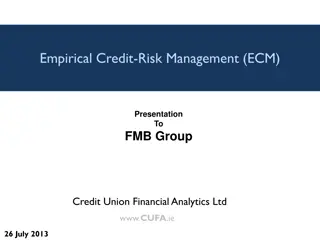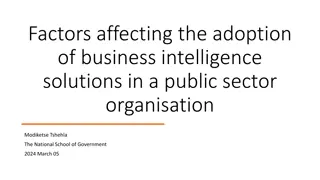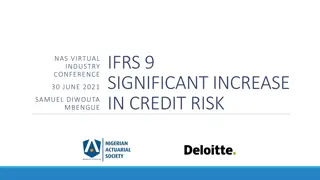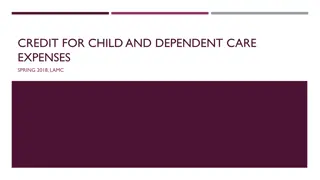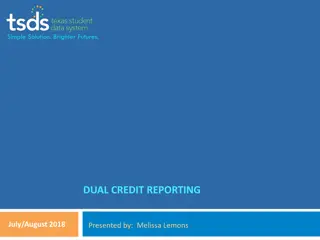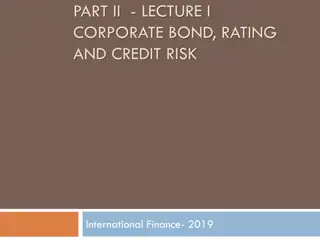Counterparty Credit Risk Assessment at the BIS: Approaches and Factors to Consider
The presentation discusses various approaches for assessing counterparty credit risk at the BIS, including full reliance on external ratings, internal risk assessment, and combinations of both. Factors such as credit risk exposures, regulatory requirements, organizational impact, skillset availability, governance, and policy changes are considered when choosing an approach. It highlights the importance of internal credit assessment, regular reviews, and the use of external assessments in determining credit grades for counterparties. Information sources for assessment include personal contacts, websites, data providers, rating agency reports, and more.
Download Presentation

Please find below an Image/Link to download the presentation.
The content on the website is provided AS IS for your information and personal use only. It may not be sold, licensed, or shared on other websites without obtaining consent from the author. Download presentation by click this link. If you encounter any issues during the download, it is possible that the publisher has removed the file from their server.
E N D
Presentation Transcript
Counterparty credit risk assessment at the BIS Giorgio Glinni Deputy Head of Credit Analysis Restricted
Agenda Counterparty credit risk assessment approaches (slides 3 4) Counterparty credit risk assessment at the BIS - general (5 6) Credit risk assessment of Sovereigns (7 16) Credit risk assessment of State Agencies (17) Credit risk assessment of Financial Institutions (18 26) Credit risk assessment of Supranationals (27 31) Credit risk assessment of non-financial Corporates (32) Credit approval and limit setting (33 34) Possible indicators for counterparty resilience (35) Useful links (36) 2 Restricted
Approaches for counterparty credit risk assessment Full reliance on external ratings Internal risk assessment Combinations of external ratings and internal risk assessment 3 Restricted
Choice of approach - factors to consider Extent of credit risk exposures Regulatory requirements Impact on organisation: Resource implications Availability of skillset Governance and ownership of risks Policy/procedural changes Potential business impact For combinations of external ratings and internal assessments, the dynamics/sensitivities of the two compontents need to be assessed 4 Restricted
Counterparty credit risk assessment at the BIS general All new counterparties are subject to internal credit assessment Regular review requirement Credit assessment is based on an internal ratings approach: Methodologies defined for different asset classes Assessment criteria include: - quantitative financial and/or economic indicators - qualitative factors using standardised definitions External assessments (eg. external ratings; market data- implied default risk) used as an additional source of information Internal credit grade ( BIS grade ) is an input into limit setting 5 Restricted
Information sources Counterparty under assessment Personal contact Website Public and Private Data providers (e.g. IMF, SNL, FACTSET etc) Standardised presentation/wide range of peers Timeliness? Rating Agency Reports/Ratings Bloomberg CDS/equity prices Sell side research Journals/newspapers/online 6 Restricted
Credit risk assessment of Sovereigns - criteria selection Economic Fundamentals / Structure Criteria Institutional effectiveness and Political risk Ability to Pay Criteria Criteria Willingness to Pay Indebtedness Criteria Debt Financing Flexibility 7 Restricted
Economic fundamentals Factors may include: Size of the economy Absolute GDP Wealth of the country GDP-per-capita Performance of the economy Real GDP growth Stability of the economy Inflation rate Competitiveness / Development of the economy World Economic Forum s Global Competitiveness ranking 8 Restricted
Institutional effectiveness Factors may include: Policy credibility and track record Budget deficits, structural reforms Level of transparency and corruption Transparency International Global Corruption Index Business environment / attitude towards investors World Bank of Doing Business Ranking Quality of country s institutions PRS Group / Economist Intelligence Unit ( EIU ) scores Attitude towards creditors Default history 9 Restricted
Political Risk Factors may include: Socioeconomic conditions / risk of social unrest United Nations Human Development Index Government stability / risk of conflict / law and order PRS Group political risk score Membership of international organisations (eg, EU etc) GDP-per-capita Event risk Qualitative assessment 10 Restricted
Indebtedness Factors may include: Government spending Government budget balance / GDP Government indebtedness Government debt/ GDP Debt affordability Government interest payments / government revenue 11 Restricted
Indebtedness (continued) Factors may include: Country spending Current account balance / GDP Consumption- or investment-driven Country indebtedness Net External debt/ GDP Debt affordability External debt service / current account receipt 12 Restricted
Debt financing flexibility Factors may include: Access to capital markets Market prices (bond yields, CDS spreads) Market-implied ratings Euromoney s access to capital markets score 13 Restricted
Debt financing flexibility (continued) Factors may include: Capacity (depth) of domestic capital markets World Bank data on stock market capitalisation Proportion of debt denominated in local currency Proportion of debt held by domestic investors 14 Restricted
One year prior to default for which country? 16 Restricted
One year prior to default for which country? 16 Restricted
Credit risk assessment of State Agencies - criteria selection Starting point: Internal grade of sovereign providing implicit guarantee or implicit support to state agency Notching from sovereign grade based on Strength of government support (government s willingness and ability to support the state agency); Standalone credit quality of state agency (based on financial ratios) 17 Restricted
Credit risk assessment of Financial Institutions - criteria selection Operating environment Criteria Company specific factors Criteria Ability to Pay Criteria Management and Governance Criteria Financial analysis 18 Restricted
Qualitative factors (I) Operating Environment - factors may include: Current - Market Conditions Consider factors such as: - General financial metrics margins delinquency rates - Competition - Regulation/creditor protection changes in regulation, bail in Outlook - Market Conditions 19 Restricted
Qualitative factors (II) Company Specific Factors - factors may include: Current - Bank Position Consider factors such as: - Business profile/bank type Investment bank/retail/specialised - Market share/pricing power - Diversification Positive/negative - Concentrations Outlook - Bank Position 20 Restricted
Qualitative factors (III) Management and Governance - factors may include: Management and Governance related factors including: - Financial reporting - Other communications - Track record re forecasts, integrations - Compliance record/governance issues 21 Restricted
Qualitative factors (IV) Liquidity and Funding - factors may include: Liquidity and funding factors including: - Access to markets - Diversification of funding mix - Other sources of liquidity - External support 22 Restricted
Quantitative factors (I) Bank Specific Financial Analysis - factors may include: Profitability Ratios such as: - ROA - Net interest margin - Cost/income - Provision/pre-provision operating income 23 Restricted
Quantitative factors (II) Bank Specific Financial Analysis - factors may include: Asset Quality Ratios including: - Impaired loans/gross loans - Loan loss reserve coverage - Concentrations (borrower/sector) 24 Restricted
Quantitative factors (III) Bank Specific Financial Analysis - factors may include: Liquidity and Funding Ratios such as: - Liquid asset ratios; liquidity coverage ratio - Loans/deposits - Term structure of funding; LT funding/Total funding - Core funding (deposits); deposits/total funding 25 Restricted
Quantitative factors (IV) Bank Specific Financial Analysis - factors may include: Capital Measures including: - Absolute amount of capital - Risk-weighted capital adequacy - Capital composition - Leverage - Internal capital generation 26 Restricted
Credit risk assessment of Supranationals criteria selection Shareholder Support Individual criteria Ability to Pay Creditor Status Individual criteria Willingness to Pay Management Policy Individual criteria Financial Profile Individual criteria 27 Restricted
Shareholder Support Supranationals are non-profit-maximising institutions that fulfil a policy role on behalf of their shareholders. As a result, shareholder support is a key rating factor for a supranational. Could consider two elements: Shareholders willingness to support the supranational and the degree to which this can be enforced. Criteria could include: - Degree of shareholders influence on (and commitment to) the supranational - Strategic importance of the supranational to its shareholders. Ability to support: Criteria could include - Credit quality of shareholders - Shareholder s economic strength - Breadth and diversity of shareholders - Callable capital / Total assets (%) 28 Restricted
Creditor Status A unique feature of supranationals, relative to commercial financial institutions, is the extent to which they enjoy preferred creditor status. This de facto status means that the repayment of supranationals loans take precedence over other creditors in the event of a sovereign default. In addition, experience shows that among borrowers, public entities are those which typically establish such priorities for debt repayment. Therefore, it is useful to gauge the institution s exposure to the public sector. Criteria may include Existence of preferred creditor status Exposure to public, or publicly-guaranteed, loans / Total Loans (%). 29 Restricted
Management Policy Consideration of supranationals typically low risk tolerance and stringent risk management policies. Relevant criteria could include: Risk tolerance and risk management practices - Credit and market risk appetite - Risk management practices - Liquidity and capital management Governance and compliance - Shareholder profile - Organisation of the risk management and compliance functions 30 Restricted
Financial Ratios The factors considered are similar to those used for assessing commercial banks, for example the following: Capital adequacy - Total equity / Total assets (%) Liquidity - Liquid Assets / Total assets (%) - LT funding / Total funding (excl. derivatives) (%) Asset quality - Impaired loans / Gross loans (%) Profitability - Net income / Total equity (%) 31 Restricted
Credit risk assessment of non-financial Corporates criteria selection Operating environment (criteria may include: cyclicality, capital intensiveness/barriers to entry; competition; regulatory oversight; growth potential; market trends) Company specific profile (criteria may include: strength of business; management/governance, corporate event risks) Financial ratios (criteria may include: operating margin; return on assets; free cash flow to sales; cash flow to debt; interest coverage; gearing; leverage) 32 Restricted
Counterparty credit risk assessment: credit approval process Credit approval process based on written procedure 3 step process: Risk Management rating and limit recommendation Banking Department - review/support Deputy General Manager (DGM)- approval All rating and limit changes require DGM approval 33 Restricted
Setting limits and maximum maturities Business considerations Qualitative Factors Size Limits & Maturity (risk bearing capacity of counter- party BIS Grade Quantitative Factors Peers Analyst Judgment 34 Restricted
Possible indicators for counterparty resilience Risk bearing capacity of counterparty ( shock absorption ) Likelihood and extent of external support (willingness and ability of support provider) Diversified business operations/revenues Competitiveness Proven adaptability to changes in the business environment; successful policy response to adverse situations Impact of operating environment/macroeconomic factors Prudent funding strategy and diversified funding mix, allowing access to funding/debt refinancing in adverse market environment 35 Restricted
Useful links http://www.fsb.org/wp-content/uploads/r_101027.pdf http://www.iosco.org/library/pubdocs/pdf/IOSCOPD488 .pdf https://ec.europa.eu/info/system/files/alternatives-to- credit-rating-study-01122015_en.pdf https://www.bis.org/bcbs/publ/d347.pdf 36 Restricted






